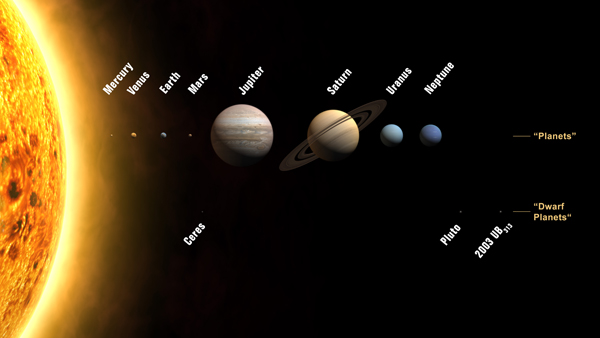
|
||||
|
|
||||
|
|
|
New definition of planet adopted by IAU
09.02.2006: The IAU has adopted a new definition of "planet" and Pluto no longer qualifies. We now officially only have eight planets in our solar system. This change in terminology does not change what's actually out there. Ultimately, it's not as important to know how we classify the various objects in our solar system as it is to learn about their physical nature and their histories. On 24 August 2006 members of the International Astronomical Union (IAU) agreed that a "planet" is defined as a celestial body that (a) is in orbit around the Sun, (b) has sufficient mass for its self-gravity to overcome rigid body forces so that it assumes a hydrostatic equilibrium (nearly round) shape, and (c) has cleared the neighbourhood around its orbit. A "dwarf planet" is a celestial body that (a) is in orbit around the Sun, (b) has sufficient mass for its self-gravity to overcome rigid body forces so that it assumes a hydrostatic equilibrium (nearly round) shape, (c) has not cleared the neighbourhood around its orbit, and (d) is not a satellite. All other objects, except satellites, orbiting the Sun shall be referred to collectively as "Small Solar-System Bodies". An IAU process will be established to assign borderline objects into either dwarf planet and other categories. These currently include most of the Solar System asteroids, most Trans-Neptunian Objects (TNOs), comets, and other small bodies.This means that the Solar System consists of eight "planets" Mercury, Venus, Earth, Mars, Jupiter, Saturn, Uranus and Neptune. A new distinct class of objects called "dwarf planets" was also decided. It was agreed that "planets" and "dwarf planets" are two distinct classes of objects. The first members of the "dwarf planet" category are Ceres, Pluto and 2003 UB 313 (temporary name). More "dwarf planets" are expected to be announced by the IAU in the coming months and years. Currently a dozen candidate "dwarf planets" are listed on IAU's "dwarf planet" watchlist, which keeps changing as new objects are found and the physics of the existing candidates becomes better known. The "dwarf planet" Pluto is recognised as an important proto-type of a new class of trans-Neptunian objects. The IAU will set up a process to name these objects. Five planets (Mercury, Venus, Mars, Jupiter, and Saturn) were known to the ancients. To the unaided eye, these planets appear starlike. However, the planets moved relative to the stars. For this reason they were called wandering stars. Our word "planet" comes from the Greek word planetes, meaning "wanderer". The planet Uranus was discovered by the noted British astronomer, Sir William Herschel, on March 13, 1781. Uranus had been observed numerous times by other astronomers as early as 1690, but it was thought to be another star. In the course of preparing a star catalog in 1801, the Sicilian astronomer Guiseppi Piazzi accidentally discovered a small planet between the orbits of Mars and Jupiter. He named the planet Ceres after the Sicilian god of the harvest. Ceres is now known to be the largest of thousands of asteroids, most of which have orbits in the region of the Solar System between Mars and Jupiter. Ceres is one of the newly classified "dwarf planets". Unlike Uranus and Ceres, Neptune was not discovered by accident. It was proposed that a planet beyond Uranus could account for irregularities in Uranus' orbit. Independently, two astronomers, John Couch Adams in England and Urbain-Jean-Joseph Le Verrier in France, calculated the position of this yet unknown planet. The search began. The British astronomer James Challis, using Adams' predictions, observed the planet on the night of August 4, 1846, but failed to compare his observations with those of the previous night and did not recognize the planet. On September 23, 1846, the planet was finally found on the first try by the German astronomer Johann Galle using Le Verrier's predictions. Several astronomers interpreted irregularities in the orbits of Uranus and Neptune as being caused by a more distant planet. Among these astronomers was the American Percival Lowell who is credited with the successful prediction of the planet's orbit. Lowell also started the search for the planet which was ultimately found in 1930 by his successors at the Lowell Observatory in Arizona. Pluto was discovered by Clyde Tombaugh of the Lowell Observatory by comparing a photographic plate taken on the night of January 23, 1930 with two others taken in the same month. Pluto has been reclassified from "planet" to "dwarf planet". 2003 UB313, discovered on October 21, 2003, is the largest known dwarf planet in the solar system. A trans-Neptunian object (TNO), it orbits the Sun in a region of space known as the scattered disc accompanied by at least one moon; the pair are currently the most distant known objects in the solar system. Mike Brown, who led the Mount Palomar-based discovery team, announced in April 2006 that the Hubble Telescope has measured 2003 UB313's diameter to be 2400 km, or slightly larger than Pluto. Its size, and the prospect of discovering other similarly-sized objects in the future stimulated the International Astronomical Union (IAU) to define the term 'planet' more precisely. Under a new definition approved on August 24, 2006, 2003 UB313 was designated a "dwarf planet". Before this clarification, it had been described as our solar system's "tenth planet" by its discoverers and NASA. This article was written by MAGS member, Mike Baldwin ©2006. Information in this article used for educational purposes under the provisions of the Fair Use Act of 1976.
References:
|
||
|
|
||||
